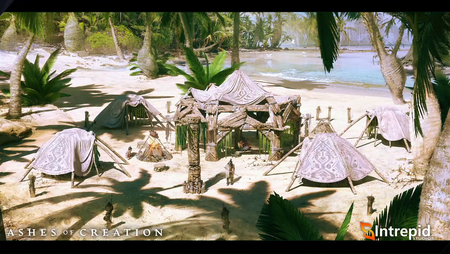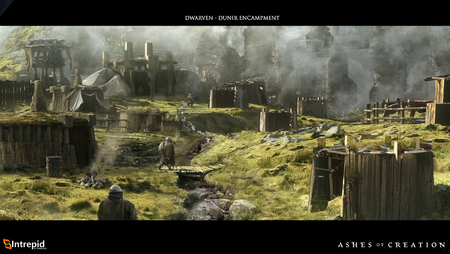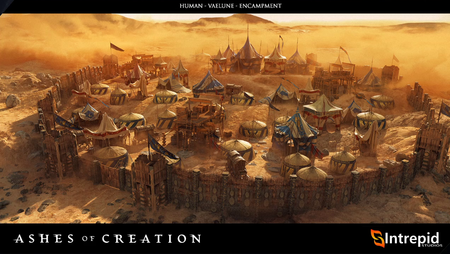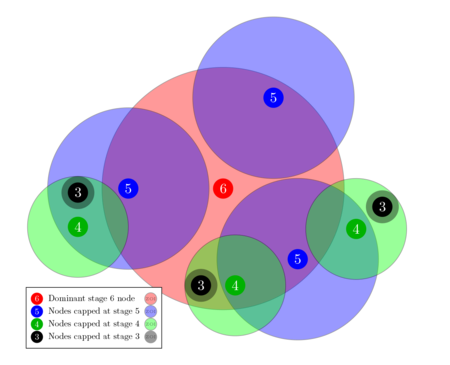Encampment
An encampment (also referred to as Camp[4]) is the second stage of node advancement.[5]
Once an Expedition becomes an Encampment, the group of NPCs grows in number, and more semi-permanent structures are in place. The Development Area feels a little more lived-in at this level, occupied with what people could build with wagons and simple tools - larger tents, smokehouses, and buildings constructed from local materials.[6] – Margaret Krohn
節點發展
玩家 (公民或非公民) 於節點的影響區域內進行活動 (任務、採集、團隊戰鬥等) 時,將有助該節點發展,提升節點至更高階段。[6][9]
隨着節點發展,其發展區域將會是出現文明的地方。節點發展至不同階段時,其發展區域內將會出現不同的建築物、NPC 和服務。節點等級愈高,發展區域便會變得愈繁盛,人口亦會變多。發展區域也會根據節點種類 (經濟、軍事、科技、神聖) 而變化。未來我們將會更詳細介紹每種節點種類。[6] – Margaret Krohn
隨着節點發展,將會有獨特遊戲內容解鎖,但其影響區域會同時擴大,限制相鄰節點的可發展等級。[10]
- 第一階段發展需時短,讓玩家可以使用售賣、存放物品等 NPC 功能。[11]
- 節點等級愈高,其影響區域愈大。[5]
- 等級較低的節點 (即附庸節點) 即使位於等級較高的節點的影響區域內,仍會獲得經驗值,但其等級不會超越上級節點。[7]
- 附庸系統將在節點發展至
[[{{{2}}}|⧼{{{2}}}⧽]] (階段 3) 時生效,但相鄰節點從
[[{{{2}}}|⧼{{{2}}}⧽]] (階段 1)便會限制鄰近節點的發展。[12][13]
The way that the algorithm expands the territories takes into account a few things: One it takes into account the coast like where's the closest coast. Two it takes into account the neighboring nodes so it can take over and essentially vassal state those nodes, but what's more important is essentially the initial population based on like how players choose their races. Because we have nine different races and four different starting points that branch out, each server's population density is going to dictate essentially the first few nodes that are highly populated and then that initial seed is what's going to determine the node structure as it moves inland into the into the world essentially; and based on the performance and successes of different sieges will determine which nodes that got locked out from the previous the initial advancements what nodes can now be available to advance further. So I really think that with so many variables that are present in the equation of how nodes advance and stay existing with the more variables you have, the higher likelihood there is for there to be a significant diversion in world progression.[14] – Steven Sharif
Normally the algorithm that's applied to the node territorial expansion will prevent significant nodes from being in close proximity to each other... There could be a perfect storm where all of the algorithmic progression of territory leads to having these nodes very close to each other because there's certain requirements that should that need to be available to satisfy node vassal takeovers; and it's possible that two nodes would never take each other over as vassals and end up close together and spanning their territories in opposite directions: The Tale of Two Cities thing.[15] – Steven Sharif
- 影響區域內的其他節點達到等級上限後,才會從這些節點獲得經驗值。[7]
- 玩家在節點升級時,與新出現的建築物處於同一位置的話,會被傳送至安全場所。[16]
- 某節點的公民仍可以協助其他節點發展。[17]
- 為了避免出現「為做而做」的情況,玩家不會明確知道節點升級實際需要多少物品或擊死多少隻怪物。[18]
Different people have different resources invested in nodes progressing and it would be a little "gamey" if you could know exactly what was necessary at that point because that would disincentivize people from participating.[18] – Steven Sharif
附庸節點
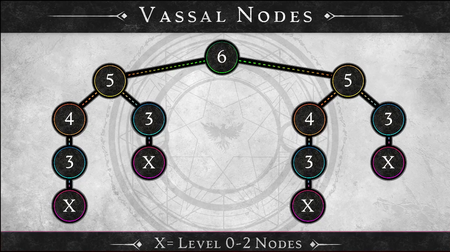
This vassal mode structure tells you what it looks like for a sovereign at a level six metropolis stage; and what it can control at a maximum vassal network is two level five nodes, of which a level five node can control one level four and one level three as direct vassals; and then the four can control a three; and every three can control a one or a two. Now if the three gets removed through siege, the one or the two is removed as well. So that's an important distinction between the three's vassals, which technically isn't really a vassal relationship because there's no citizenships possible. Those vassals don't exist between three and X, but they do exist between four and three, five and four, and six and five. And what this also allows is that because there are 85 nodes that are within the world, we have a buffer zone of about 20 nodes that lives in a max server state. So if you had maximum five metropolises form in a world, you will have a number about 20 nodes that can live alongside those metropolis networks; and when or if a metropolis falls, that extra cushion of nodes around the five metropolis structures allows for the map to be redistricted in a way that is unique. It doesn't mean that one of the fives is just going to pick up where the last six left off and form the same exact metropolis structure. From a territory perspective it has ancillary nodes to play with and expand towards that redistricts the map, so that if a metropolis falls there's a significant difference in the layout of the world and the layout of these almost nation-like territories.[19] – Steven Sharif
Village (stage 3) or higher nodes enslave nearby nodes, converting them into vassal nodes.[8][13]
- A
[[{{{2}}}|⧼{{{2}}}⧽]] (階段 6) can control up to two
[[{{{2}}}|⧼{{{2}}}⧽]] (階段 5) nodes. A
[[{{{2}}}|⧼{{{2}}}⧽]] (階段 5) can control one
[[{{{2}}}|⧼{{{2}}}⧽]] (階段 4) and one
[[{{{2}}}|⧼{{{2}}}⧽]] (階段 3) node. A
[[{{{2}}}|⧼{{{2}}}⧽]] (階段 3) can control an
[[{{{2}}}|⧼{{{2}}}⧽]] (階段 2) or an
[[{{{2}}}|⧼{{{2}}}⧽]] (階段 1). If the
[[{{{2}}}|⧼{{{2}}}⧽]] (階段 3) gets destroyed through a siege, its dependant
[[{{{2}}}|⧼{{{2}}}⧽]] (階段 2) and
[[{{{2}}}|⧼{{{2}}}⧽]] (階段 1) nodes are also destroyed.[19]
- There is a layer of intricacy between how the neighboring nodes advance and what potential parent structure they have in the vassalship tree.[20] – Steven Sharif
- Vassal nodes gain benefits from their regent node (also referred to as sovereign node or parent node) even if the node type of the parent is different to the vassal.[21][22]
- It is not a bad thing to be vasseled, it is a good thing to be vasseled. It brings many benefits from the Sovereign, which is the ultimate parent of that vassal network down to the vassal node itself; and it allows that vassal node to even live outside of its normal mechanics. You get to adopt some of the benefits that the node type of your sovereign is, even if your node type as a vassal node isn't the same.[22] – Steven Sharif
- Regent nodes collect taxes from their vassal nodes. These taxes cannot be taken by the mayor or other players.[24]
- Vassal nodes must remain at least one node stage below their parent node.[8]
[[{{{2}}}|⧼{{{2}}}⧽]] (階段 1) upward block the growth of their immediate neighbors. This was intended to be tested in Alpha-1.[12][13]
- Vassal nodes give excess experience to their parent node and may have their own vassals; so long as they fall within the parent node’s zone of influence.[24][8]
- If a node is capped and is both a vassal and has its own vassals, any experience earned from itself or its Vassals is first applied to its own deficit. Experience beyond that is then sent to its parent node.[6]
- When the vassal reaches its cap it overflows experience up to the parent; and so it can be very good early on for parents to get vassal nodes that are very productive- that have a lot of traffic.[24] – Steven Sharif
- Vassals are subject to the government, alliances, wars, taxes, and trade of their parent node, and are able to receive federal aid from them.[8]
- Vassal nodes cannot declare war on their parent node or any of their vassals.[8]
- Citizens of vassals are bound by the diplomatic states of the parent node.[8]
- If a Node is a Vassal Node and is capped from advancing further, it first applies any experience earned to its own deficit (see Node Atrophy section), and then applies excess experience earned to its Parent Node. If the Parent Node advances and the Vassal is able to grow, it becomes uncapped. If a Node is capped and is both a Vassal and has its own Vassals, any experience earned from itself or its Vassals is first applied to their own deficit. Any experience beyond that is then sent to its Parent Node.[6] – Margaret Krohn
節點佈局與風格
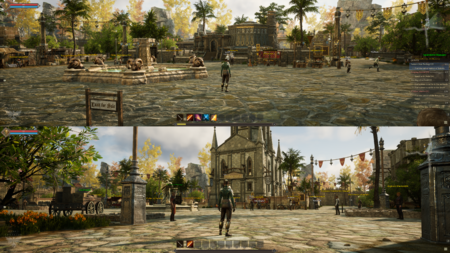
The layout and architecture within a Node’s development area are determined by influential race. For example, a stage 3 Node with the majority of player contribution being Py'rai would have a Py'rai village with Py'rai architecture. Most NPCs would be Py'rai elves, and offer questlines within the Py'rai narrative.[8] – Margaret Krohn
Each player’s contributed experience is flagged with their character race and other identifiers. When a Node advances, the race with the highest experience contribution determines the Node’s style and culture. This style and culture change can happen at every Node Stage. For example, if a Node advances to Level 2 - Encampment Stage and 51% of all experience was earned by Ren’Kai players, the Node will be a Level 2 Ren’Kai Node. If that same Node advances to a Level 3 - Village Stage Node, but the Py'Rai contributed 62% of all the experience earned, then the Node will be a Level 3 Py'Rai Node.[6] – Margaret Krohn
節點佈局與風格 is determined by several factors:[25][26]
- The way that the node system is built is that they can exist across a spread of 18 biomes, but at the same time have to represent the cultural influence of these cultures that are intrinsically a part of a specific biome.[27] – Steven Sharif
- Environment (biome) and location of the node.[27][25][26]
- Nodes will adjust the local topography to fit the aesthetic and mechanical requirements of the node.[28]
- Currently the way that the platform system is set up, is it's capable of adjusting the topography of the node's footprint, regardless of the surrounding terrain. So the reason for that is we want to have flexibility in the presentation of the node's layout and how it is essentially both from an aesthetic standpoint as well as a mechanical standpoint with node sieges- how it's constructed and that construction should have the ability to take on a variance of different types of topography. So it shouldn't be dependent on the surrounding area. Now that's not to say that the surrounding area isn't going to have some influence over. So for example... we're experimenting a little bit with the platform tech and putting up a node up against the side of a mountain or on the edge of a cliff or something that has a beautiful vista. Those are things that we're going to test out obviously as we continue to work on the node tool and how that platform system works, but the idea is to have the node independent of the surrounding terrain.[28] – Steven Sharif
- Some parts are determined by the area it's in. Some parts are determined by the type it is. Some parts are determined by the race it is; and then the rest of it is determined by the mayor.[26] – Jeffrey Bard
- Race that contributed the highest percentage to the node's advancement will alter the racial appearance of its buildings, NPCs, and props.[29][30][25][6][26][31][32]
- All nodes, whether they're associated with a castle or associated with normal node structure, has cultural influences that replicate over to the buildings that are produced and the NPCs that are present.[34] – Steven Sharif
- The rest is determined by the node's mayor.[26]
- It should be possible for a node to complete several building projects within a mayor's one month term in office.[35]
- Q: How long would you say it will take players on average to fill/build up a node completely from wilderness to metropolis?
- A: It's one thing to get a node to a certain level: it's another thing to develop the node; and I can't really give you an on-average expectation, because there's a lot of variables at play. There's how many citizens does the node have attracted to it; what's the type of traffic that the node is attracting to it based on things like its tax rates, or the specialization that it chose to spec into, based on the building types it's chosen to build. All of those things are variables that can affect the quote-unquote "average build-out time" of a particular node. So it's difficult to give you an average when there's so many variables along those lines. But the idea is that if there is a particular project that players are interested in in developing based on the node stage, that they would have the ability to complete several of those projects as within a single term of a mayor; and a term of a mayor is one month.[35] – Steven Sharif
種族影響
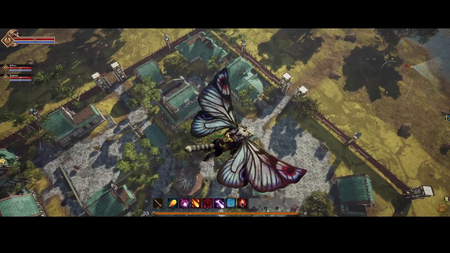
We have essentially sets that exist across all races; and each race that dons those armor sets is going to have their own racial influence on the presentation of those particular sets. So that's something that's unique in how each of the races get diversified. Additionally, the more that one particular race contributes to a node's development, it's going to manifest in that particular node's architectural influences. You're going to see the architectures of those races become manifest within the nodes as well: That's another way that we diversify each race and we present each race's culture in the game as through those architectures, through those props that exist, through the tailoring of the armor sets that the NPC might wear, to the different factions that exist. Factions will have their own affiliation with different races as well. Each race will also have some different nomenclature when it comes to the lore, or comes to locations in the world. They're going to have their own language influences as well: The way they speak is something that's going to be distinct between races; when you have dialogue trees with particular NPCs. So all of those things really go into setting an immersive world where the cultures have their own identity.[29] – Steven Sharif
Cultural influences manifest in many ways, from node and gear aesthetics to NPC languages and lore.[29][37][6]
- 裝備外觀 of certain armor sets is influenced by the player's race.[29]
- 節點佈局與風格 is influenced by the race that contributes the most to that node.[29]
- There is an attrition and that attrition on experience and influence is heightened based on the performance of the race in the world. So if all these nodes are Orc nodes then their attrition rate is very high to compete with the cultural establishment of new nodes because they have more influence in the world and a popular opinion is against them in their outlying regions that they do not have influence in.[38] – Steven Sharif
NPC 種族互動
- NPCs will react differently to different character races.[39]
- Languages will be distinct between NPC 種族 and in the lore.[29]
- Certain quest givers and NPCs may only be present at nodes with certain cultural influences.[40]
- Depending on the cultural influence of the node activates certain types of quest lines and/or sponsors. Some of those are shared, some of those are general. Some of those relate to a progression path that is a first time user experience. Those will be constant across all culture types. Some of them, however, are predicates that spawn when certain story arcs and/or events, or commissions or buy orders become present within the node; and those might change based on the cultural influence of the node. So there is a separation between those populations.[40] – Steven Sharif
Monster coin events
Legion monster coin events are common events that occur for 節點 up to the 村莊 stage. This might include a horde of zombies rolling across the countryside finding something or someone to feast on. Players who wish to keep their advancements will need to be vigilant.[41]
视觉效果
2021-12-27
其他
引用
- ↑ 直播, 2020-02-28 (52:40).
- ↑ 直播, 2019-11-22 (50:56).
- ↑ 直播, 2020-01-30 (1:07:50).
- ↑ 直播, 2018-12-12 (14:48).
- ↑ 5.0 5.1 Node series part II – the Metropolis.
- ↑ 6.0 6.1 6.2 6.3 6.4 6.5 6.6 6.7 6.8 6.9 Blog - Know Your Nodes - Advance and Destroy.
- ↑ 7.0 7.1 7.2 直播, 2017-10-16 (50:20).
- ↑ 8.0 8.1 8.2 8.3 8.4 8.5 8.6 8.7 8.8 Blog - Know Your Nodes - The Basics.
- ↑ A reactive world - Nodes.
- ↑ 影片, 2017-04-20 (0:02).
- ↑
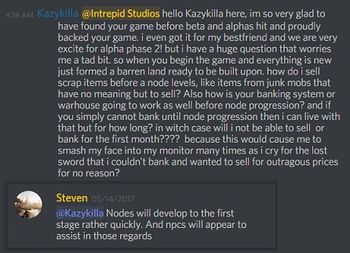
- ↑ 12.0 12.1

- ↑ 13.0 13.1 13.2

- ↑ 14.0 14.1 訪談, 2020-07-18 (10:04).
- ↑ 15.0 15.1 訪談, 2020-07-08 (1:00:15).
- ↑ 直播, 2017-11-17 (55:27).
- ↑
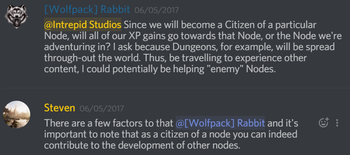
- ↑ 18.0 18.1 直播, 2017-05-26 (28:16).
- ↑ 19.0 19.1 19.2 直播, 2022-08-26 (1:07:34).
- ↑

- ↑ 直播, 2023-08-31 (52:56).
- ↑ 22.0 22.1 直播, 2022-08-26 (1:04:35).
- ↑

- ↑ 24.0 24.1 24.2 直播, 2022-08-26 (1:10:16).
- ↑ 25.0 25.1 25.2 直播, 2020-10-30 (39:17).
- ↑ 26.0 26.1 26.2 26.3 26.4 26.5 直播, 2018-09-27 (53:06).
- ↑ 27.0 27.1 直播, 2022-02-25 (41:00).
- ↑ 28.0 28.1 直播, 2021-02-26 (1:12:18).
- ↑ 29.0 29.1 29.2 29.3 29.4 29.5 直播, 2022-03-31 (4:57).
- ↑ Podcast, 2021-04-11 (29:47).
- ↑ 訪談, 2018-05-11 (54:34).
- ↑ 直播, 2017-05-26 (21:23).
- ↑ Podcast, 2021-04-11 (23:36).
- ↑ 34.0 34.1 訪談, 2018-05-11 (47:27).
- ↑ 35.0 35.1 直播, 2022-07-29 (1:13:09).
- ↑ 直播, 2020-06-26 (45:32).
- ↑ 37.0 37.1 訪談, 2021-02-07 (33:00).
- ↑ 38.0 38.1 訪談, 2018-05-11 (1:00:19).
- ↑ 39.0 39.1 Podcast, 2018-04-23 (29:56).
- ↑ 40.0 40.1 訪談, 2023-07-09 (1:35:28).
- ↑ 直播, 2017-05-03 (36:25).
